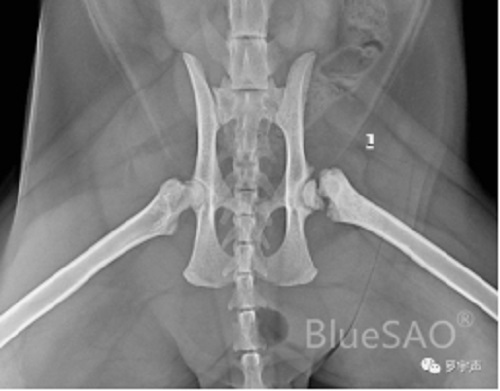Old Femoral Neck Fractures - Total Hip Replacement at BlueSAO
Breed: Fold cat, Gender: Male, Weight: 8.1kg, Age: 4 years and 3 months
This is a very well behaved and fat Fold cat. It was examined in an out-of-town hospital a few years ago for lameness, but no obvious abnormality was found. The lameness has returned in recent times. Although not a purebred Foldcat, one would suspect that this cat may have Folded Ear Disease - chondrodysplasia. Feeding chondroitin can help alleviate the condition. The pet owner got around to takingx-rays for the cat at the local hospital, and tests revealed a stale fracture of its left femoral neck. The pet owner looked up a lot of information about treating old fractures. There are several options for the cat's current condition: first, no surgery, which means conservative treatment with long-term pain medication to relieve the pain; second, femoral head resection surgery, which will relieve the pain but will definitely not be too good for weight bearing; third, total hip replacement surgery with a new artificial joint to replace the existing diseased hip joint, which will allow the cat to walk normally and painlessly with weight bearing, but the cost will be higher than the second option. The pet owner found me through my official account, and we had a conversation. The pet owner soon made up his mind to make an appointment with me to treat the cat.
For the vast majority of hip diseases, my recommendation is total hip replacement surgery for treatment as long as one can afford it. This is because only a new joint can give the patient a pain-free hip and a better quality of life. Nowadays, I basically do not recommend femoral head resection surgery. The femoral head will form a prosthetic joint after resection. Although it relieves the pain for a short time, in the long term, it will inevitably lead to pain, limp, muscle atrophy, and decreased quality of life regardless of weight. Moreover, this is a disabling surgery and the hind limbs cannot bear weight normally. This procedure was also done before total hip replacement was available or mature because there were no better options. There are better medical techniques and better medical outcomes, so why not present them to pet owners as an option?
For this fat cat, the difficulties of total hip replacement surgery were as follows: firstly, the cat was too fat, the surgical incision was deep leading to unclear surgical view, and the angle of the acetabular cup was easy to open when it was placed; secondly, the marrow cavity of the proximal femur had obvious osteosclerosis, and it was difficult to open the marrow cavity of the femur, which required good patience, but absolutely no violence to open the marrow cavity, otherwise the femur would easily fracture.
We first used the iBlueVet orthopedic planning software to give this fat cat precise preoperative planning and then used the BlueSAO Small Canine and Feline Bone Cement Hip Replacement System to give him a new artificial joint.
The planned implants were a #3 femoral stem and 12mm acetabular cup. (+0) 8mm, (+2) 8mm, and (+4) 8mm femoral heads were used as spares.
Four preoperative x-rays of the pelvis in dorsaland lateral position, and the femur in dorsaland lateral position were taken.

Orthopedic Instruments We Use BlueSAO